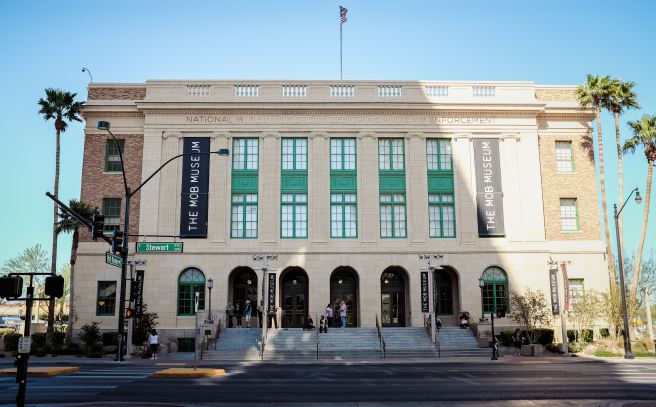Of the many theoretical shenanigans made possible by time travel, towards the top of my list would be this:
Late 1933. American Prohibition has just ended. I walk into the beautiful, brand-new, Neo-classical Las Vegas courthouse and post office building, approach the nearest official, and smile winningly.
I inform them that in fewer than 100 years, their basement—yes, this very one—will be home to a government-endorsed functioning speakeasy, complete with in-house moonshine operations.
I just want to see how they’d react.

Behold the National Museum of Organized Crime and Law Enforcement—better known as the Mob Museum. Poised prominently on Stewart Avenue, mere blocks from the Las Vegas Strip, this museum tells the complicated, nuanced story of organized crime in Las Vegas and the United States and the ways it has influenced (and in many ways forced) the evolution of American law enforcement.
Here, you’ll meet all the familiar players: Al Capone, Lucky Luciano, Bugsy Siegel on one side; J. Edgar Hoover and the fledgling FBI on the other. Through three floors of the Mob Museum (including a second-floor courtroom that was directly involved with some of the real-life mafia investigations), visitors explore the ways organized crime arrived and developed in the United States, the ways it sprawled across the country and guided Las Vegas’ own unique history, the ways law enforcement learned and changed in order to combat it, and the ways organized crime continues to manifest worldwide today.
The Mob Museum is decidedly Las Vegan in all the best ways. When the historical building (already listed in the National Register of Historic Places) was retired and turned over to the city in 2002, the promise was that it would be restored and used for some kind of cultural purpose. A museum, for instance.
Trouble was, people just don’t come to Las Vegas looking for fine art. Tourists come to Vegas for dazzle. For pleasure. For spectacle.
For scandal.
So the City of Las Vegas created a history museum with their audiences in mind: an educational experience that leans into the seedier side of American history. They opened their doors on February 14th, 2012 (the anniversary of the Saint Valentine’s Day Massacre) and have been a prized Las Vegas institution ever since.
What impresses me most—and I’ll have readers know I spent over four hours meandering when I visited last month—is that the Mob Museum could’ve created a larger-than-life celebration of history’s excesses and left it at that. But they did not.
Instead, the Mob Museum has achieved a skillful, thoughtful balance between Las Vegan pageantry and scholarly nuance. Make no mistake: this museum is an experience, with the occasional theatrical lighting, sound effects, and unflinching gore. But the Mob Museum is also absolutely devoted to its educational goals. Subject matter is treated with complication, the web of history carefully pieced apart and explored bit by bit. Historical figures are given dimension. Weight is given to historical circumstance, to cultural evolution, and to sprawling impact beyond crime versus law.
The Mob Museum makes a compelling case for the study of organized crime—not as a fringe topic, but one that bears extensive exploration in understanding our current American culture. And it does so while maintaining all requisite Las Vegas flair.
Even their interactive Prohibition exhibit, i.e., The Underground, a basement speakeasy—a triumph of exhibit design, in my opinion—balances Sin City decadence with attention to historical detail. They go so far as distilling their own 100 proof corn moonshine, “as authentic as it can safely get,” in a custom-built pot still. Prohibition-era cocktails are available for purchase. For obvious reasons, this part of the museum is only accessible by those age 21 and above.
See the actual wall from the Saint Valentine’s Day Massacre. Sit in the Las Vegas courtroom that housed one of the national Kefauver Committee hearings. Explore the development of the Federal Bureau of Investigation. Watch how Mob money flowed through Las Vegas casinos and funded crime across the country. Learn the many ways current law enforcement organizations in Las Vegas and across the United States are learning to better serve their communities, particularly where lethal force intersects with race and intrinsic bias.
I can’t recommend the Mob Museum enough. It’s not for young kids—even with gore warnings placed before particularly graphic exhibits—but it is absolutely worth a long visit if you’re at all interested in history, true crime, and the ways real human beings struggle to make their way to the top.
Have you ever visited the Mob Museum, or a similar museum in another city? Have you ever delved into something that you expected to be a “fringe” topic, only to discover it had a much more broad cultural impact? Tell us about your experience in the comments below!

I can’t wait to go there!
LikeLiked by 1 person
Okay… you’ve piqued my curiosity, Crystal 🙂 Mob Museum is now on my list of ‘gotta’ visit one day’.
LikeLiked by 1 person
Yay! It really is fascinating, and was put together with such dedication. And it helped me with conceptualizing some stuff in my novel, too, Big Bad-wise! Because let’s be honest – I don’t come naturally to the idea of criminal enterprising. My “shadiest” behavior involves telling 6-year-olds that cinnamon toast is “spicy” so they’ll let their mother eat in peace, haha!
LikeLiked by 1 person